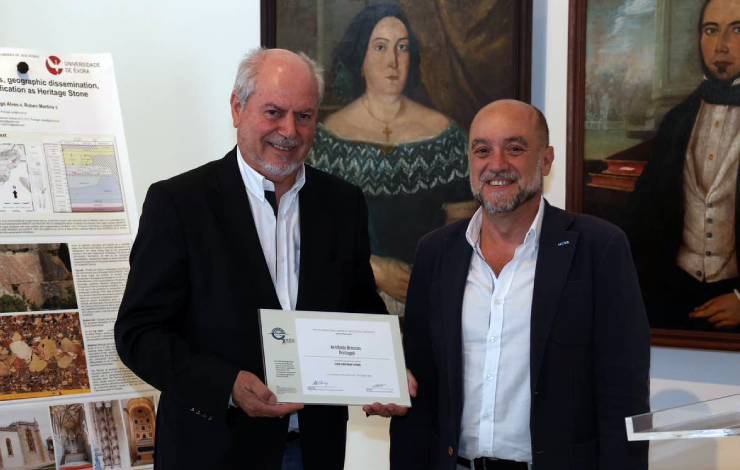21-07-2023

Photos: Setúbal City Council - on top, Mayor of Setúbal and Dean of NOVA FCT with the IUGS certification.
The "Brecha da Arrábida" has recently been classified as a "World Heritage Stone" by the International Union for Geological Sciences (IUGS) - a UNESCO partner NGO, in a process of recognized geological importance led by José Carlos Kullberg, professor and researcher at the Department of Earth Sciences of NOVA FCT.
The certificate was presented by the Dean of NOVA FCT, José Júlio Alferes, on July 28th in Setúbal, during the celebration of the 47th anniversary of the Arrábida Natural Park.
"This certification attests to the importance of the "Brecha da Arrábida" and its exceptional use throughout history. It is a honor for me to deliver, on behalf of the International Union of Geological Sciences, this unique distinction to the people of Setúbal, through the hands of the Mayor," stated the Dean.
The event also featured a lecture titled "The"Brecha da Arrábida"– World Heritage Stone" by José Carlos Kullberg. The professor and researcher from the Department of Earth Sciences at NOVA FCT led the classification process of this geological heritage.
During his speech, José Carlos Kullberg called for "greater valorization and promotion of the Jaspe quarry" to safeguard "the last site of enormous scientific value for the "Brecha da Arrábida"."
The "Brecha da Arrábida" is an ornamental rock found exclusively in the municipality of Setúbal. Its historical use dates back to Roman times, as evidenced by structures like the Roman Road of Viso and the Roman Ruins of Troia, which employed it for structural purposes. Its ornamental application began with the construction of the Church and Convent of Jesus, including parts used for both ornamentation and structure, such as the portico and main window on the exterior and columns and ceiling support arches on the interior. Subsequently, it became widely used in nearly a hundred monuments in Portugal, many of which are classified as National Heritage, as well as in seven foreign countries where it has been documented. Its diverse colors are the reason for its widespread use in decorative pieces throughout the country, especially during the Baroque period.
This was the first time that an ornamental rock, whose exploitation has been prohibited since 1976, has received such a distinguished classification.

Jose Carlos Kullberg, professor and researcher from the Department of Earth Sciences at NOVA FCT, who led the classification process of this geological heritage, during his speech.